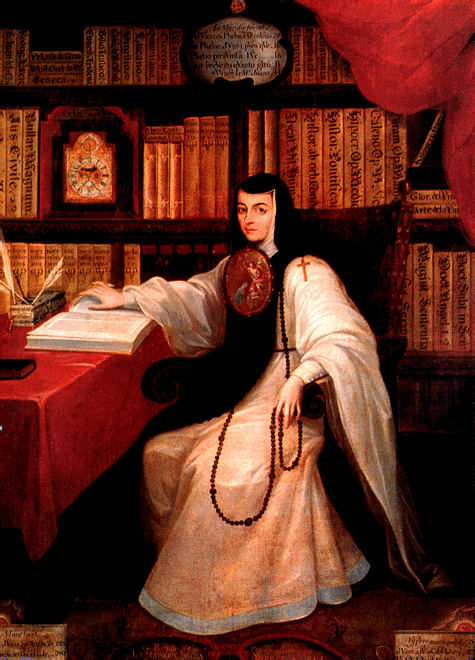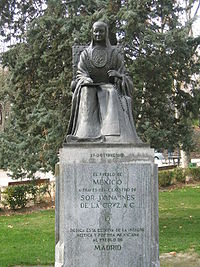
[From the Wikipedia Article]
Sor Juana was born (November 12, 1651. Some biographers record her birth year as [1648,] – April 17, 1695).
She was known as Sor Juana Inés de la Cruz, and also by her full name: Sor Juana Inés de la Cruz de Asbaje (or Asuaje) y Ramírez de Santillana
Sor Juana was a self-taught Novohispana scholar, nun, poet, and a writer of the Baroque school. Though she lived in a colonial era when Mexico was part of the Spanish empire, she is considered a Mexican writer, and a precursor to later Mexican literature.
Life and Literary Production
She was born in San Miguel Nepantla, State of Mexico. During a time when bloodlines strictly dictated class and status, Sor Juana began life as the illegitimate daughter of a nobleman. Her mother was born in Yecapixtla,(present day State of Morelos). Her grandfather had acquired property in the central region of the Valley of Mexico, eventually Don Pedro Ramirez settle down in the region of Chalco and so Juana was raised in village life.She was a gifted child who hid in the hacienda chapel to read her grandfather's books from the adjoining library, something forbidden to girls. She taught herself Latin before she was ten years old- and would cut off a lock of hair each time she forgot something. By adolescence, she had mastered Greek logic, and at age thirteen she was teaching Latin to young children.
In 1664, at age sixteen, Juana was sent to live in Mexico City, and came under the tutelage of the Vicerreine Leonor Carreto, wife of Antonio Sebastian de Toledo, Marquis de Mancera.
In 1667, she entered the Convent of the Discalced Carmelites of St. Joseph, but only remained there briefly. In 1669, she entered the Convent of the Order of St. Jerome where she would remain until her death.[1]
There is ongoing debate by some moderns, questioning whether she had a personal romantic life, as love is often nuanced in her poems, and her language is often a sensory and sometimes seeming ecstatic one. Coming from poetic traditions in pre-conquest Mexico wherein poetry was high art --and relationship with the gods was often spoken about in terms of erotic lyricism-- and also with the Spanish overlay of the great Catholic saints who portrayed themselves as "lovers of God" and "brides of Christ," etc., the debate continues about whether her writings are literal or allegorical.
In her time, the convent was the only refuge in which a female could properly attend to education of her mind, spirit, body and soul. In Sor Juana's era, educating girls was not only non-existent, but often considered by Spanish prelates to be the dark work of the Devil.
Nonetheless, Sor Juana wrote literature centered on freedom. In her poem "Redondillas" she defends a woman's right to be respected as a human being. In "Hombres necios" (Stubborn men), she criticizes the sexism of the society of her time, poking fun at and revealing the hypocrisy of men who publicly condemn prostitutes, yet privately pay women to perform on them what they have just said is an abomination to God.
Sor Juana's asks the sharp question in this ages old matter of the purity/whoredom split found in base male mentality: 'Who sins more, she who sins for pay? or he who pays for sin?'
Developing her themes further, she wrote a romantic comedy entitled Los empeños de una casa about a brother and a sister entangled in webs of love, elucidating the themes of love and jealousy. She did not moralize, but rather, in the spirit of her lifetime interests, inquired of how these deeply emotional matters shaped and carved a woman's pursuit of liberty, knowledge, education and freedom to live her life in self-sovereignty.
Her 'thinking out loud' was especially dangerous because the Counter Reformation was raging. Anyone who challenged societal values and ecclesiastical dogma could be marked by the Church as a heretic, and thereby harmed by the Church bearing false witness against the person; by the Church silencing them; forcing them into penitence, or else stripping them of property and assets, including those of one's family; they could be tortured, exiled, imprisoned or murdered.
Matters came to a head in 1690, when a letter was published attacking Sor Juana's focus on the sciences, and suggesting that she should devote her time to soft theology.
However, powerful representatives from the Spanish court were her mentors and she was widely read in Spain, being called "the Tenth Muse." She was lauded as the most prominent poet of the post-conquest American Continent. Her work was printed by the first printing press of the American Continent in Mexico City.
In response to clergy who sought to reprimand her, Sor Juana wrote a letter entitled Respuesta a Sor Filotea (Reply to Sister Filotea,) in which she defended women's right to any education they desired. The Catholic Church, via the Archbishop of Mexico joined other high-ranking officials in condemning Sor Juana's "waywardness."
By 1693, Sor Juana seemingly ceased writing rather than risk further Church censure. However, there is no undisputed evidence of her renouncing devotion to letters, though there are documents showing her agreeing to self-humiliation. Her name is affixed to such a document in 1694, but given her deep natural lyricism, the tone of these supposed hand-written penitentials is rhetorical and autocratic Church formulae- one signed, "Yo, la peor de todas" (I, the worst of all).
She is said to have sold all her books then, an extensive library of over 4,000 volumes... her musical and scientific instruments as well. According to some investigators, her books of her own works were burnt by the Inquisition as she was forced into silence by Church hierarchy.
Only a few writings remain which are known as the "Complete Works." According to Octavio Paz, Sor Juana's writings were saved by the Viceroy's wife. Some sources have speculated they were lovers. In April 1695, after ministering to the other sisters struck down by a rampant plague, she is said to have died at four in the morning on April 17.
Literary Criticism
Arguably the most important book devoted to Sor Juana is by Octavio Paz (who won the 1990 Nobel Prize in Literature). Paz's book, titled Sor Juana: Or, the Traps of Faith,[2] is a work devoted to a contemplation of her poetry, life, and times in the context of the "other" history of New Spain, particularly focusing on the difficulties women then faced when tried to thrive in the academic and artistic fields.Octavio Paz describes how he had been drawn to her work by the enigmas of Sor Juana's personality and life paths. Why did she become a nun? How could she renounce her lifelong passion for writing and learning? Paz knew that such questions could be answered only in the context of the world in which she lived, and so he begins his study with a portrayal of the life and culture of New Spain and the political and ideological forces at work in that autocratic, theocratic, male-dominated society, in which the subjugation of women was absolute.
In his book, Paz makes a thorough analysis of Sor Juana's poetry and traces some of her influences to the Spanish writers of the Golden Age and the Hermetic tradition, mainly derived from the works of Athanasius Kircher. Paz analyses Sor Juana's most ambitious and extensive poem, "First Dream" (Primero Sueño) as largely a representation of the desire of knowledge through a number of hermetic symbols, albeit transformed in her own language and skilled image-making abilities. In conclusion, Paz makes the case that Sor Juana's ouvre was the most important body of poetic work produced in the Americas until the arrival of XIXth century figures such as Emily Dickinson and Walt Whitman.
Just as Paz illuminates Sor Juana's life by placing it in its historical setting, he situates her work in relation to the traditions that nurtured it. Paz singled out the qualities that distinguish her work and mark her uniqueness as a poet. For Octavio Paz, Sor Juana's writings, like her life, epitomize the struggle of the individual, and in particular the individual woman, for creative fulfillment and self-expression, for integration of soul, spirit, and mind, not just as a contemplative, but in real ways in the real world.



